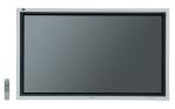Plasma
Plasma

Description
Plasma display devices have higher resolution than most conventional TV sets, and are capable of displaying full HDTV and DTV signals as well as XGA, SVGA, and VGA signals from a computer. Most plasma monitors can accept any video format. There are two types of plasma screen: EDTV (for ?enhanced definition television?) and HD. HD-compatible screens are capable of displaying full-resolution HD-standard video, most often from commercial DVD or television broadcast, and are compatible with less robust formats. Plasma screens have no scan lines because each and every pixel cell has its own transistor electrode. This creates a smooth, evenly lit image across the entire surface of the display. Most current displays also include built-in line doubling to improve image quality from low-resolution video signals. Plasma screens also provide uniform brightness, illuminating all pixels evenly across the screen, and offer a viewing angle of 160 degrees (top to bottom and left to right) - much better than rear-projection TVs and LCD displays. This allows a larger number of viewers to enjoy proper image reproduction from a wider variety of locations throughout the exhibition space. One drawback: Because plasma screens use phosphors to generate light, they can be subject to "burn-in" - that is, when a static image is left on the screen for a long time, it may not completely disappear when the image changes.